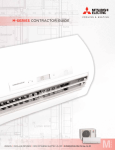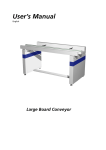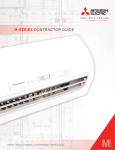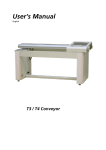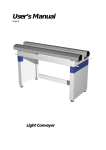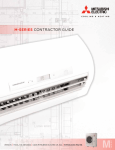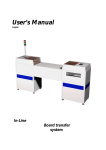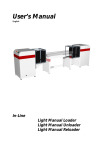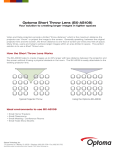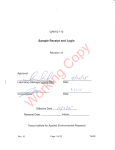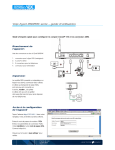Download User`s Manual
Transcript
User’s Manual English In-Line Telescopic gate conveyor User´s Manual This manual is intended for the inline device specified on the previous page. The manual contains information to assist the operator to start and operate the device properly, and to maintain it. Hardware and software mentioned in this document are subjected to continuous development and improvement. Consequently, there may be minor discrepancies between the information in the document and the performance and design of the hardware and software. Specifications, dimensions and other statements mentioned in this document are subject to change without prior notice. The manufacturer and its suppliers shall not be liable for any damages related to the software or hardware, or for any other damages whatsoever caused by the use of, or inability to use any manufacturer’s products. This is applicable even if the manufacturer has been advised of the damage risk. Under any circumstances, the manufacturer’s entire liability shall be limited to replace such defective software or hardware, which was originally purchased from the manufacturer. Printed in Sweden. ep770_020923u.doc/ 2002-09-23 2 User´s Manual Contents 1. SAFETY................................ SAFETY................................ ................................ ................................ .. 4 Emergency stop .......................................................................................................................... 5 Warning signs ............................................................................................................................. 5 Warnings ..................................................................................................................................... 6 Noise............................................................................................................................................. 6 2. ABOUT THE DOCUMENTATION DOCUMENTATION ................................ ................................ 7 User's manual .............................................................................................................................. 7 3. INSTALLATION................................ INSTALLATION................................ ................................ ....................... 8 4. PRODUCT DESCRIPTION................................ DESCRIPTION................................ ................................ ........ 10 Control system ......................................................................................................................... 12 5. OPERATION ................................ ................................ ......................... 13 Setting up the machine for operation .................................................................................. 13 Alarms ........................................................................................................................................ 13 Alarm table................................................................................................................................ 13 6. MAINTENANCE ................................ ................................ .................... 14 Maintenance schedule............................................................................................................. 14 Maintenance instructions ....................................................................................................... 14 Lubrication ................................................................................................................................ 15 Lubricant specification............................................................................................................ 16 7. SERVICE ................................ ................................ .............................. 17 Exchange of conveyor belt drive motor ............................................................................... 17 Exchange of conveyor belt ..................................................................................................... 19 Exchange of belt rollers ........................................................................................................... 19 Figures Figure 1-1 Electric shock ............................................................................................................... 5 Figure 1-2 Attention ...................................................................................................................... 6 Figure 4-1 Main parts .................................................................................................................. 10 Figure 4-2 Trimmers .................................................................................................................... 11 Figure 4-3 Manoeuvre panel ...................................................................................................... 12 Figure 6-1 Lubrication................................................................................................................. 15 Figure 7-1 Remove cover ............................................................................................................ 17 Figure 7-2 Motor and c able ........................................................................................................ 18 Figure 7-3 Drive shaft.................................................................................................................. 18 Figure 7-4 Belt roller.................................................................................................................... 19 ep770_020923u.doc/ 2002-09-23 3 User´s Manual 1. Safety Before starting the machine, it is essential that the operator, the foreman, and any other personnel involved in the machine operation understand the following points: ep770_020923u.doc/ 2002-09-23 • The Telescopic gate conveyor is designed to transfer PCB’s and let people and vehicles pass through a production line. The machine must be used exclusively for these purposes and no other. • The machine must be operated by trained personnel only. • Anyone operating this machine must obey all warning signs. See the section entitled Warning Sign in this chapter. • All personnel involved in machine operation must understand the use of the emergency stop button and how to move machine elements in an emergency. See the following sections entitled Emergency Stop. • Do not use chemicals or other substances, which may have any influence on the operator or other personnel involved in the machine operation. • Apart from weekly, monthly and yearly maintenance as described in the Maintenance chapter of the User's Manual, the machine is to be serviced by authorized personnel only. • All covers and shields must be intact, mounted and closed while the machine is in operation. • Do not disable or disengage any built-in safety switches or sensors. • No hands or fingers are allowed near the moving parts of the machine. 4 User´s Manual Emergency stop The emergency stop button is positioned on the top of the steel frame and stops all movements of the machine immediately when activated. The emergency stop button has to be pulled up or turned counter clockwise to enable restart of the machine after an emergency stop. The machine must always be switched off when hands, fingers, tools or other objects are in the danger area of movable machine elements. Warning signs The warning sign on the machine must be observed as this machine contains electrically live parts. The warning sign on the machine is placed on the cover of the electrical cabinet. Figure 1-1 Electric shock The sign must be kept clean and readable. If the sign is missing, it must be replaced immediately. The sign warns of electric shock. Units on which this sign is placed contain dangerous voltage levels. Power must be switched off before opening the unit. Only authorized service personnel are allowed to operate the machine when the unit is open. This sign is applied as follows. One sign on the cover of the electrical cabinet. ep770_020923u.doc/ 2002-09-23 5 User´s Manual Warnings Throughout the manual this symbol is used to call your attention when a task is about to be performed, that could be harmful to personnel or damage the machine. The symbol often refers to the warning signs, which must be obeyed to eliminate the risk of injury. If there are instructions accompanying this symbol, they must be followed. Figure 1-2 Attention Noise The machine noise is considerably less than 70 dB(A). ep770_020923u.doc/ 2002-09-23 6 User´s Manual 2. About The Documentation User's manual The User's Manual contains information to assist the operator to start and operate the machine properly. The Operator's Manual is divided into the following main parts: Chapter l: Safety instructions. Chapter 2: Information about the documentation. Chapter 3: Installation instructions. Chapter 4: Description of the machine and its basic operation. Chapter 5: Operational information for production. Chapter 6: Maintenance instructions. Chapter 7: Service instructions, available products and options. ep770_020923u.doc/ 2002-09-23 7 User´s Manual 3. Installation Delivery The machine is delivered fixed on a pallet. Preparation Before the installation, prepare the location so, that electric power is available. Ambient conditions The ambient air must Allowed humidity: 0 to 35'C 35 to 60'C Allowed temperature: Operating Storage Technical data Length be clean. 10 to 90 % noncondensing 10 to 60 % noncondensing 5 to 40 'C (41 to 104 'F) -40 to 60 'C ( -40 to 104 'F) See specification included in the contract. Voltage Frequency Power consumption, 100-240 VAC 50/60 Hz max. 800 W Board sizes: Length Width Width W508 Thickness 50-480 mm (2.0-18.9”) 50-360 mm (2.0-14.2”) 50-508 mm (2.0-20.0”) 0.8-4.0 mm (0.03-0.2”) The machine can be lifted with a forklift truck. Put some wooden boards between the forks and the frame parts before lifting. ep770_020923u.doc/ 2002-09-23 8 User´s Manual Installation The installation must be carried out by authorized service personnel. The complete machine line must be carefully levelled along the telescopic gate conveyors belts. Use a spirit level across and along the machines belts when adjusting the feets of the machine. The fundament must be rigid and sturdy. The machine must not rock. The machine must be placed in a manner that allows access to all parts of the machine and so that service actions are not obstructed. There must be a free space of one meter around the machine, except for the other machines included in the production line. Mains supply To be connected by authorized electrician. The transformer can be adapted to different voltages. Refer to the electrical drawings for information on how to connect the transformer for the different voltages. On newer models there can be an auto-adaptable voltage device fitted. ep770_020923u.doc/ 2002-09-23 9 User´s Manual 4. Product Description Overview Overview The Telescopic gate conveyor consists of a solid steel framework, a telescopic conveyor, one DC-motor. It is also equipped with a control panel and an electrical cabinet. A photo sensor is positioned at the end of the belt section. B A D C E Figure 4-1 Main parts A. B. C. D. E. ep770_020923u.doc/ 2002-09-23 Control panel. Emergency stop button. Photoelectric trip device. (Curtain type safety sensor) Telescopic conveyor. (The picture shows the extracted position) Electrical cabinet and connectors for supply voltage and SMEMA. (Behind the cover plate) 10 User´s Manual Function The telescopic gate conveyor (TGC) transfers boards over a normally open personnel and vehicle gateway. When there is a board on an upstream machine the TGC receives a signal that says board available. The TGC sends back a ready signal and the board is transported into the TGCs conveyor. When the subsequent machine signals that it is ready to receive a board, the telescopic conveyor extracts, signals that a board is coming and transports the board out from the conveyor. When the board has left the TGC, the conveyor retracts to its waiting position. SMEMA function setup The smema function of the TGC can be changed via Trimmer#1 on the PLC in the electrical cabinet. Do not change the position of Trimmer#2. Set trimmer#1 to minmin- position The conveyor extracts to the outer position when a board arrives and gives Smema Out Board Available. Board transfer starts when the TGC receives Smema Out Ready from the subsequent machine. Set trimmer#1 to middlemiddle- position The conveyor stays in the retracted position when a board arrives. When the TGC receives a Smema Out Ready, the conveyor is extracted and board transfer starts. Set trimmer#1 to max - position The conveyor stays in the retracted position when a board arrives and gives Smema Out Board Available. When the TGC receives a Smema Out Ready , the conveyor is extracted and board transfer starts. Trimmer#1 Trimmer#2 Figure 4-2 Trimmers ep770_020923u.doc/ 2002-09-23 11 User´s Manual Control system Control panel for the telescopic gate conveyor A B Figure 4-3 Manoeuvre panel A. B. Manoeuvre switch with built-in signal lamp Control switch Manoeuvre switch: When set to ”OFF” the machine is stopped and the power supply to all moving parts disconnected. When set to ”ON” it starts up the machine and makes it ready for production. Signal lamp: Indicates the current machine state. There are three possible states. 1. The light is out: The manoeuvre switch is “OFF” or the machine has no supply voltage. 2. The light is continuously lit: The manoeuvre switch is “ON” and no error has occurred. The machine is ready for production. 3. The light is flashing: An error has occurred. See the alarm table in chapter 5 for possible causes. Control switch: Increases or decreases the conveyor width. Width movement continues until the control switch is released or an end limit is reached. Check the conveyor for obstructive objects before adjusting the width. If width adjustment is performed while e.g. a PCB is located on the conveyor, damage may occur in the width adjustment mechanism. ep770_020923u.doc/ 2002-09-23 12 User´s Manual 5. Operation Setting up the machine for operation Turn the Manoeuvre switch to “ON”. Adjust the width of the conveyor. Width movement continues until the control switch is released or an end limit is reached. Make sure the PCB can be moved manually through the whole length of the conveyor without getting jammed. The machine is now ready for production. Alarms An alarm state is always indicated by a flashing signal lamp. See Control system, signal lamp, in chapter 4 for more information. Reset an alarm state by turning the Manoeuvre switch to “OFF”, and then back to “ON”. Alarms cannot be reset if the Emergency stop button is pressed down (activated). Alarm table Alarm type Descrip tion Recommended action Telescope timeout 1 The telescopic movement did not finish within predefined time. Something prevents the telescopic conveyor from reaching end position. The telescopic movement did not finish within predefined time. One or more telescope limitswitch is broken. (See electrical drawings.) The Emergency stop button is pressed down. Remove the obstructive object and reset the machine according to the reset procedure described above. Telescope timeout 2 Emergency stop ep770_020923u.doc/ 2002-09-23 Replace the broken limit-switch(es) and reset the machine. Pull the Emergency stop button up and reset the machine. 13 User´s Manual 6. Maintenance The maintenance of the machine is an important task and must never be overlooked. Follow the maintenance schedule and keep the machinery in a clean condition. Maintenance schedule Weekly: • Keep the machine clean, See "Cleaning". Monthly: • Check the running surfaces under the conveyor belts for cleanliness and clean if necessary. See "Cleaning". • Check the conveyor belt condition and renew the belts if required. • Lubricate the four linear bars for telescopic movement. See “Lubrication”. Yearly: • Lubricate the threaded rods, guideways for width adjustment, and linear carriages. See “Lubrication” Maintenance instructions General: • Keep the machine clean all over. If necessary, vacuum clean the area inside the machine as thoroughly as possible. Photo sensor: • One of the most sensitive parts is the photo sensor located at the end of the conveyor. If it becomes clogged by dust, the machine will not work. Wipe off dust from the sensor using a soft cotton rag. Telescopic conveyor: • Check the running surfaces under the conveyor belts. If they have become dirty and sticky, clean them with a rag and some washing -up detergent. ep770_020923u.doc/ 2002-09-23 14 User´s Manual Lubrication All bearings are of sealed type and do not require any additional lubrication. Threaded rods and guideways for width adjustment: A. Lubricate the threaded rods and guideways for width adjustment. See Figure 6-1(A). Apply a small amount of lubricant to the entire length of the rod, and both sides of the guide. Drive the moving rail to both end positions when lubrication is done. Guideways for telescopic movement: B. Lubricate the four guideways that hold the conveyor assembly. See Figure 6-1(B). Apply a small amount of lubricant to the entire length and both sides of the bars. Linear carriages for telescopic movement: C. Lubricate the 10 linear carriages. See Figure 6-1(C). Apply a small amount of lubricant to the surface of the carriages wheels. C C B C A B B C A C B Figure 6-1 Lubrication ep770_020923u.doc/ 2002-09-23 15 User´s Manual Lubricant specification Unless other is stated, use the OKS 270 grease. Grease should be applied in small amounts, just to give a thin film. OKS 270 OKS 270 is the base lubrication grease for the machine. Data Full product name: OKS 270 Type: Grease paste Colour: Whitish Flash point: >210°C S upplier in Sweden TriboTec AB Box 203 S-435 24 Mölnlycke, Sweden Phone: Nat. 031-88 12 70 Int. +46 31 88 12 70 Manufacturer OKS Spezialschmierstoffe GmbH Postfach 500466 80974 Munich, Germany. Phone: Nat. 089-14 98 920 Int. +49 89 14 98 920 ep770_020923u.doc/ 2002-09-23 16 User´s Manual 7. Service Exchange of conveyor belt drive motor 1. Turn the manoeuvre switch to “OFF” when the telescopic conveyor is in its extracted position. Disconnect the power supply at the mains plug. 2. Unscrew the two screws holding the black plastic cover plate at the end of the conveyor, using a 3 mm Allen key 3. Remove the aluminium cover plate by pulling it straight out and up, then pushing it straight forward. Figure 7-1 Remove cover ep770_020923u.doc/ 2002-09-23 4. Remove the drive belt from the drive wheel on the motor that is to be exchanged. 5. Remove the two cables from the drive motor, using a soldering iron. Check the markings so you reconnect them correctly. 17 User´s Manual 6. Unscrew the four M3 screws that hold the drive motor, using a 2.5 mm Allen key, then pull out the drive motor and the belt drive wheel. Remove the straps that hold the cables to the drive motor. Figure 7-2 Motor and cable 7. Unscrew the setscrew that holds the belt drive wheel to the drive shaft using a 1 mm Allen key. Mount the belt drive wheel on the new drive motor. Figure 7-3 Drive shaft 8. Replace the new drive motor with the M3 screws, using a 2.5 mm Allen key and solder back the cables. Finally, replace the drive belt. 9. Fit the aluminium cover plate and tighten the black plastic cover plate with the two screws, using a 3 mm Allen key. 10. Reconnect power supply. ep770_020923u.doc/ 2002-09-23 18 User´s Manual Exchange of conveyor belt 1. Disconnect the power supply at the mains plug. 2. Remove the conveyor belt by pulling it to the side. 3. Fit the new belt by pushing it in place from the side. Exchange of belt rollers 1. Turn the manoeuvre switch to “OFF” when the telescopic conveyor is in its extracted position. Disconnect the power supply at the mains plug. 2. Remove the conveyor belt by pulling it to the side. 3. Remove the black plastic cover using a 3 mm Allen key. 4. Remove the aluminium top cover by pulling it straight out and up, then pushing it forward. 5. Unscrew the M6 nut using a 10 mm monkey wrench (BE adjustable spanner) and replace it with the new belt roller but the old M6 nut and washer. Figure 7-4 Belt roller ep770_020923u.doc/ 2002-09-23 6. Replace the conveyor belt. 7. Replace the aluminium cover and the black plastic cover, using a 3 mm Allen key. 19



















